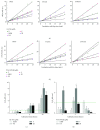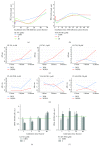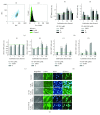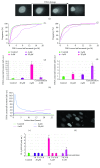Antioxidant Properties of Fullerene Derivatives Depend on Their Chemical Structure: A Study of Two Fullerene Derivatives on HELFs
- PMID: 30800207
- PMCID: PMC6360044
- DOI: 10.1155/2019/4398695
Antioxidant Properties of Fullerene Derivatives Depend on Their Chemical Structure: A Study of Two Fullerene Derivatives on HELFs
Abstract
Oxidative stress is a major issue in a wide number of pathologies (neurodegenerative, cardiovascular, immune diseases, and cancer). Because of this, the search for new antioxidants is an important issue. One of the potential antioxidants that has been enthusiastically discussed in the past twenty years is fullerene and its derivatives. Although in aqueous solutions fullerene derivatives have shown to be antioxidants, their properties in this regard within the cells are controversially discussed. We have studied two different water-soluble fullerene C60 and C70 derivatives on human embryonic lung fibroblasts at a wide range of concentrations. Both of them cause a decrease in cellular ROS at short times of incubation (1 hour). Their prolonged action, however, is fundamentally different: derivative GI-761 causes secondary oxidative stress whereas derivative VI-419-P3K keeps ROS levels under control values. To gain a better understanding of this effect, we assessed factors that could play a role in the response of cells to fullerene derivatives. Increased ROS production occurred due to NOX4 upregulation by GI-761. Derivative VI-419-P3K activated the transcription of antioxidant master regulator NRF2 and caused its translocation to the nucleus. This data suggests that the antioxidant effect of fullerene derivatives depends on their chemical structure.
Figures








Similar articles
-
Dose-Response Effect of Various Concentrations of Cl-Containing Water-Soluble Derivatives of C60 Fullerenes on a Selective Regulation of Gene Expression in Human Embryonic Lung Fibroblasts (HELF).Front Biosci (Landmark Ed). 2024 Oct 12;29(10):352. doi: 10.31083/j.fbl2910352. Front Biosci (Landmark Ed). 2024. PMID: 39473423
-
Effects of Aqueous Dispersions of C60, C70 and Gd@C82 Fullerenes on Genes Involved in Oxidative Stress and Anti-Inflammatory Pathways.Int J Mol Sci. 2021 Jun 7;22(11):6130. doi: 10.3390/ijms22116130. Int J Mol Sci. 2021. PMID: 34200169 Free PMC article.
-
Toxic and DNA damaging effects of a functionalized fullerene in human embryonic lung fibroblasts.Mutat Res Genet Toxicol Environ Mutagen. 2016 Jul;805:46-57. doi: 10.1016/j.mrgentox.2016.05.004. Epub 2016 May 13. Mutat Res Genet Toxicol Environ Mutagen. 2016. PMID: 27402482
-
Fullerene derivatives: an attractive tool for biological applications.Eur J Med Chem. 2003 Nov-Dec;38(11-12):913-23. doi: 10.1016/j.ejmech.2003.09.005. Eur J Med Chem. 2003. PMID: 14642323 Review.
-
[Fullerenes in biology].Postepy Biochem. 2007;53(1):91-6. Postepy Biochem. 2007. PMID: 17718393 Review. Polish.
Cited by
-
Structure and Vibrational Spectroscopy of C82 Fullerenol Valent Isomers: An Experimental and Theoretical Joint Study.Molecules. 2023 Feb 6;28(4):1569. doi: 10.3390/molecules28041569. Molecules. 2023. PMID: 36838557 Free PMC article.
-
Toxicity and Antioxidant Activity of Fullerenol C60,70 with Low Number of Oxygen Substituents.Int J Mol Sci. 2021 Jun 15;22(12):6382. doi: 10.3390/ijms22126382. Int J Mol Sci. 2021. PMID: 34203700 Free PMC article.
-
Carbon Based Nanodots in Early Diagnosis of Cancer.Front Chem. 2021 May 24;9:669169. doi: 10.3389/fchem.2021.669169. eCollection 2021. Front Chem. 2021. PMID: 34109155 Free PMC article. Review.
-
Identification of potential descriptors of water-soluble fullerene derivatives responsible for antitumor effects on lung cancer cells via QSAR analysis.Comput Struct Biotechnol J. 2021 Jan 16;19:812-825. doi: 10.1016/j.csbj.2021.01.012. eCollection 2021. Comput Struct Biotechnol J. 2021. PMID: 33598097 Free PMC article.
-
Electrostatic effects on water-soluble fullerene derivatives interaction with cytochrome c and cytochrome c oxidase.J Biol Phys. 2023 Jun;49(2):269-282. doi: 10.1007/s10867-023-09631-5. Epub 2023 Mar 18. J Biol Phys. 2023. PMID: 36932295 Free PMC article.
References
MeSH terms
Substances
LinkOut - more resources
Full Text Sources
Medical
Miscellaneous

